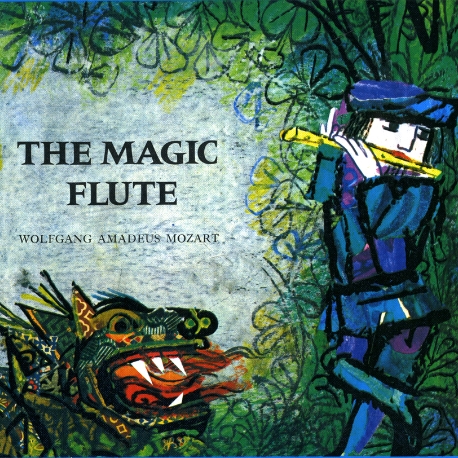
Overview
Synopsis
Die Zauberflöte was Mozart’s final opera before he died in 1791. Its magical setting and show stopping arias made the opera’s premiere a major success, and have constantly led many to consider it one of if not his best opera ever. The aria “Der Hölle Rache”, also referred to as the Queen of the Night’s aria, is one of the most popular operatic arias of all time. With its heroic love story and loveable characters, Die Zauberflöte is one of the best loved and most performed operas each year, and is a great opera for the whole family to enjoy.
Show Information
Context
Die Zauberflöte was the final opera that Mozart composed before his death. It is technically considered a Singspiel, which is a theatrical piece with spoken dialogue, very similar to what is now considered a musical. Mozart collaborated with Emanuel Schikaneder for Die Zauberflöte. Schikaneder was the impresario of the Freihaus-Theater auf der Wieden where Die Zauberflöte was premiered. In addition to writing the libretto for opera, Schikaneder also starred as Papageno in the original
to read the context for Die Zauberflöte and to unlock other amazing theatre resources!Plot
ACT 1
The young prince Tamino is lost in a distant land and is being chased by a large serpent. Terrified, and without a weapon, Tamino is calling to the Gods for help (“Zu Hilfe! Zu hilfe!”). He is exhausted from the pursuit and faints. Luckily, three ladies, attendants to the Queen-of-the-Night, appear and rescue Tamino by killing the serpent. The ladies see the unconscious prince and examine his state. They find him very attractive and each tries to convince the others to leave them alone
to read the plot for Die Zauberflöte and to unlock other amazing theatre resources!Characters
| Name | Part Size | Gender | Vocal Part |
|---|---|---|---|
|
Lead |
Male |
Tenor |
|
|
Lead |
Female |
Soprano |
|
|
Lead |
Male |
Baritone |
|
|
Lead |
Female |
Soprano |
|
|
Lead |
Male |
Bass |
|
|
Supporting |
Male |
Tenor |
|
|
Supporting |
Female |
Soprano |
|
|
Supporting |
Female |
Alto |
|
|
Supporting |
Female |
Soprano |
|
|
Supporting |
Female |
Soprano |
|
|
Featured |
Male |
Tenor |
|
|
Featured |
Male |
Bass |
|
|
Featured |
Male |
Treble/Boy Soprano |
|
|
Featured |
Male |
Bass |
|
|
Featured |
Male |
Tenor |
|
|
Featured |
Male |
Bass |
|
|
Ensemble |
Male |
Spoken |
|
|
Ensemble |
Male |
Spoken |
|
|
|
Either Gender |
|
Songs
- ACT 1
- Introduction - Zu Hilfe! Zu hilfe! (Tamino, 1st Lady, 2nd Lady, 3rd Lady)
- Aria - Der Vogelfänger bin ich ja. (Papageno)
- Aria - Dies Bildnis ist bezaubernd schön (Tamino)
- Recitative & Aria - O zittre nicht, mein lieber Sohn...Zum Leiden bin ich auserkoren (Queen of the Night)
- Quintet - Hm! Hm! Hm! - (Tamino, Papageno, 1st Lady, 2nd Lady, 3rd Lady)
- Trio - Du feines Täubchen, nur herein! (Monostatos, Pamina, Papageno)
- Duet - Bei Männern, welche Liebe fühlen (Pamina, Papageno)
- Finale - Zum Ziele führt dich diese Bahn...(3 spirits, Tamino, Speaker, Pamina, Papageno, Monostatos, Sarastro, chorus)
-
Excerpt Aria - Wie stark ist nicht dein Zauberton (Tamino)
- ACT 2
- March of the Priests
- Aria & Chorus - O Isis und Osiris schenket der Weisheit Geist (Sarastro)
- Duet - Bewahret euch vor Weibertücken (Two Priests)
- Quintet - Wie? Ihr an diesem Schreckensort? (1st Lady, 2nd Lady, 3rd Lady, Papageno, Tamino)
- Aria - Alles fühlt der Liebe Freuden (Monostatos)
- Aria - Der Hölle Rache kocht in meinem Herzen (Queen of the night)
- Aria - In diesen heilgen Hallen (Sarastro)
- Trio - Seid uns zum zweitenmal willkommen (3 spirits)
- Aria - Ach, ich fühl’s, es ist verschwunden (Pamina)
- Chorus - O isis und Osiris! Welche Wonne! (chorus)
- Trio - Soll ich dich, Teurer! Nicht mehr sehn? (Pamina, Sarastro, Tamino)
- Aria - Ein Mädchen oder Weibchen (Papageno)
- Finale - Bald prangt, den Morgen zu verkünden (3 spirits, Pamina, 1st Man in armor, 2nd man in armor, Tamino, Papageno, Papagena, Monostatos, Queen of the Night, 1st, 2nd, & 3rd Lady, Sarastro, Chorus)
- Aria Excerpt - Papagena, Papagena, Papagena (Papageno)
A song with an asterisk (*) before the title indicates a dance number; a character listed in a song with an asterisk (*) by the character's name indicates that the character exclusively serves as a dancer in this song, which is sung by other characters.
Monologues
Scenes
Key Terms
Sorry! We do not currently have terms for this guide.
Videos
Quizzes
Themes, Symbols & Motifs
Sorry! We do not currently have learning modules for this guide.
Quote Analysis
Sorry! We do not currently have learning modules for this guide.
